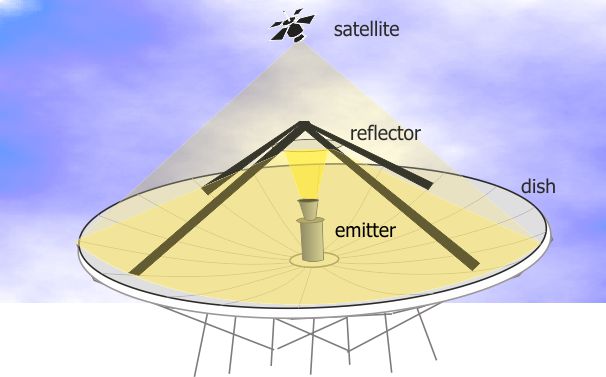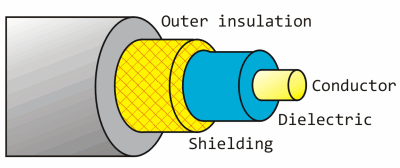Freesat reception - all about dishes
 Brian Butterworth published on UK Free TV
Brian Butterworth published on UK Free TV Satellite reception has both advantages and disadvantages compare with terrestrial (aerial) reception.
By using much higher frequencies (gigahertz, compared to terrestrial televisions megahertz) more transmission channels called transponders (the satellite equivalent of multiplexes) can be provided. For example, there are only six Freeview multiplexes, but Sky or Freesat users can access two hundred satellite transponders.
Aside from exceptional weather conditions (very heavy rain for example) digital satellite provides stable pictures and audio. Where Freeview transmitters are no more than 732 metres above sea level, the geostationary satellites used for television are 35,800,000 metres above the equator so reception is possible even where buildings, trees and hills make terrestrial reception impossible.

The downside of the transmitters being 22,300 miles up in the air is that the signals are very, very weak - so standard TV aerial is of little use. When the signals are sent to the satellites, huge dish transmitters are used to uplink the signal to the satellite. These are tens of metres from side to side, and feature an emitter that generates the signal, which is first bounced of a mirror (called a reflector) and then off the surface of the parabolic dish.

There are many satellites in the sky over the equator. Often these are in clusters over a particular position, for example there are four used for UK television are at 28.2 degrees east. There is another cluster over the 19.2 degrees east positions that are used for German television.
To receive these very weak signals from the satellite, it is necessary to use a dish for reception too. By using a reflective dish, this concentrates the signals onto a small device called a LNB. This is held in front of the dish by a metal arm.

The size of dish for reception is typically much smaller; often 60cm to 100cm in diameter, but the exact size depends upon the transmitting satellite transponder. To keep the transmission power levels down to levels that can be powered by the satellite's solar panels, each beam is focused on a particular area of the Earth's surface. If you are trying to receive the signal at the centre of this zone, a small dish is required. At the outer edges, you may need a 5 metre dish. Maps of these zones are provided by the satellite companies, and are called satellite footprints.
When the dish is installed it must be aligned carefully as the signal is very weak. The installer needs to know the inclination and the azimuth from the ground location to the satellite. If you install yourself you will find that there are markings on the dish that are used to point the dish in the correct position. It is important that the view of the satellite will not be blocked, so must take into account leaves growing on trees and potential building works.
For many people the LNB will have a single cable connected to it, however if you have Sky+ or a multi-room installation the LNB package will actually contain four receivers a quad-LNB. Unlike terrestrial television where you can split the aerial cable to feed more than one Freeview box or television set, with satelite reception you cannot. So, a Sky+ box with two receivers (so you can watch one thing and record another) has two cables connecting the box to the dish.
The cable that connects the dish to the receiver must be satellite grade cable. Whilst this looks superficially like the cable used to connect and aerial to a television, a higher grade cable is required for satellite reception.
Here is an image of a co-axial cable. This sort of cable is used to connect any type of receiving aerial to the reception equipment.

RG6, PF100 and PH100 are all types of coax cable that are suitable for the very weak signals that are received by a satellite dish. (The power is the same as you would receive from a one-bar electric heater on the moon).
The conductor in the centre passes the signals received from the dish to the set-top box. This is made from steel in RG6 cable, and from copper in the RF100 and PH100 types. This makes RG6 less suitable in the UK where rain can damage the cable.
The shielding is responsible for keeping unwanted external interference from damaging the signal. In the cheaper cable this will be a foil wrap, in better specified cables this is a braid (or mesh) of copper wires. The sheild in the RF100 covers 58% of the cable.
The non-conducting layer between the shield and the conductor is called the dielectric. This can be either a solid (RG6), foam (RF100) or air-spaced (PH100) dielectric. This makes the cables progressively more flexible (ie bendy without damage).
10:18 AM
i currently subscribe to sky but can i also attach a freesat box to the sky dish, so that i can get sky in one room and freesat in another?
| link to this comment |
8:36 PM
I am thinking of buying Freesat. What is best, a single/ double or quadruple LNB ?
Iive on the coast in West Sussex what size dish is best suited to this area ?
| link to this comment |
a.keevil: Buy a quad-LNB, they are reasonably priced and will allow you to add devices without having to throw away your old LNB package.
A 60cm dish is used in England.
| link to this comment |
11:26 PM
hi i hav a sky dish and use to use a sky pls box if i bought freesat plus box and plugged it in will this work and record 2 channels
| link to this comment |
7:38 AM
richard gains: Basically yes, as dishes used for Sky are completely compatible for use with Freesat TV's / boxes.
Also, if the LNB on the dish is of the dual or quad variety then it can operate with a Sky box at the same time as a Freesat one.
| link to this comment |
8:19 AM
richard gains: Of course the "dual" aspect of my latter comment only applying for purely TV use, as any dual channel Freesat recorder requires to use both inputs from the LNB, so a quad LNB is essential if any other Satellite device is intended to be used as well as the Freesat recorder.
| link to this comment |
10:39 AM
Hello,
I am installing a satellite dish and I can either put it on the wall of the house where it looks as though a neighbour's tree might get in the way of the signal elevation or on the wall of a very solid cabin in the garden where the tree is well out of the way. My question is, how far away can the dish be from the TV itself? I would use PF100 cable, but would I lose signal strength over a certain length? The cabin wall would be between 10 and 25 metres from the TV, depending on how I routed the cable.
| link to this comment |
7:36 PM
Nick: Max. cable distance for a standard mini dish is getting on for 50m (that's around 15dB loss for good quality coax - i.e. the stuff that is copper rather than copper plated steel or aluminium).
A bigger dish will provide more signal, so can tolerate a larger loss, and you can get amplifiers powered by the satellite receiver up the coax to overcome some cable loss.
At 25m max. you should be fine, unless you're living way up north.
| link to this comment |